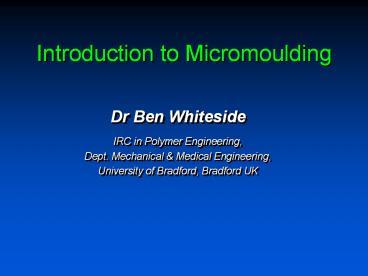Introduction to Micromoulding - PowerPoint PPT Presentation
1 / 31
Title:
Introduction to Micromoulding
Description:
Can be used to study very small areas of a component to measure:- Surface finish ... Ridges' caused by the tools used to make the cavity. Structures inside the product ... – PowerPoint PPT presentation
Number of Views:63
Avg rating:3.0/5.0
Title: Introduction to Micromoulding
1
Introduction to Micromoulding
- Dr Ben Whiteside
- IRC in Polymer Engineering,
- Dept. Mechanical Medical Engineering,
- University of Bradford, Bradford UK
2
Contents
- Micro/nanotechnology
- Micromoulding
- Challenges
- Process Technology
- Mould Manufacture
- Product Assessment
3
Capsule Endoscopy
Capsule contains Camera Transmitter
Optics Battery
4
Capsule Endoscopy
Full colour images for diagnosis of bowel problems
5
Digital Micro mirror Device (DMD)
Texas Instruments
16 mm x 16 mm pixel geometry
6
Micro-assembly Laser-fibre alignment- packaging?
7
Lab-on-a-Chip devices
Circuits similar to conventional silicon circuits
but using fluids rather than electricity
Allows rapid chemical and biological screening of
samples Each chamber in the illustation contains
1/1 000 000 000th of a litre!
8
Current Manufacturing Techniques
Silicon wafer techniques requiring Clean-room
fabrication Expensive Illumination Processes
9
Micro-Injection Moulding
- Can the injection moulding process be adapted to
offer a cheap, high output process for the
production of micro-scale components?
10
Challenges
- Controlling the moulding machine
- Melting the polymer
- Measuring the required amount of material
- Injecting the material rapidly
- Making the moulds
- Contain very fine details
- Need to be durable
- Checking/Packaging the product
- Quality control
- Handling very small products
11
Standard IM material waste
- Conventional Moulding
- 4-cav. Mould
- Part weight 4 mg
- Sprue weight 2530 mg
- Shot weight 2546 mg
- Material efficiency 0,16
- Cycle time 17 sec.
courtesy Battenfeld
12
Standard IM Material Degradation
Picture of injection barrel here
- Screw/barrel typically contains 500g polymer
- Assuming a 0.5g product running every 20 seconds
material would be at melt temperature for 5½
hours - Material can degrade
13
Battenfeld Microsystem 50
- Purpose built micro injection process
- Servo-electric injection
- Optimum screw size 14mm
- Automatic parts handling
- Clean room filtration
- Modular
14
Battenfeld Microsystem 50
15
POM Micro-gear
Part weight 0,0008 g
courtesy Battenfeld
16
Polycarbonate hearing aid sensor housing
courtesy Battenfeld
Weight 2,2 mg
17
Micromoulding the truth?
18
Making the moulds
- Moulds need to have
- Very accurate dimensions
- Good surface finish
- Good durability
19
Making the moulds - Micromilling
Cutters as small as 0.1mm rotating at speeds up
to 120 000 rpm All held in special housing to
minimise vibration and changes in temperature
20
Making the moulds Micro Electro Discharge
Machining
The electrode and woprkpiece are connected to a
DC power supply and are brought close together,
but never touch Sparks jump across the small gap
which heats up the workpiece metal to about
1200ºC, causing it to evaporate
21
Making the moulds Laser Machining
High frequency pulsed lasers focussed on the
steel causing it to evaporate. The laser is aimed
using a computer to cut out a cavity in the
steel Problems can occur when the steel
spatters or is recast in the local area
22
Making the moulds Micro-Stereolithoraphy
Object is built up of slices created by
illuminating the top surface of a bath of special
polymer with a laser When a slice is complete,
the stage holding the part drops down a fraction
of a millimeter so the next slice can be made
23
Making the moulds Micro-Stereolithoraphy
T-Shaped cavity made for us by Rutherford
Appleton Labs Electroplating required to create
mould Cylinders will form holes for pins to eject
the moulded part
24
Making the moulds LIGA Process
- Able to form a number of cavities simultaneously
- Excellent surface finish
- Only 2.5D structures
- Requires expensive hardware
25
Product Assessment
- How is quality control implemented for such small
components? - Optical systems
- How do we find out how rigid and hard the product
is? - Need to use Atomic Force Microscopy techniques
26
Machine Vision Systems
Robot
Product
CCD Camera
- Fully Automatic no user intervention required
- Able to measure dimensions/areas/geometric
features - Can be performed during the process
27
Machine Vision Systems
Smallest product moulded at the
University Largest diameter 1mm Mass 0.34mg
28
Atomic force microscopy
Can be used to study very small areas of a
component to measure- Surface finish Internal
structure Mechanical properties hardness etc
29
Surface details
Ridges caused by the tools used to make the
cavity
30
Structures inside the product
Indent
Rose patterns tell us about the structure of the
polymer and how strong we can expect the product
to be Indent shape also indicates how hard the
product is
31
Conclusions
- Standard injection moulding machines are not well
suited for producing microscale components - Micromoulding offers a cheap and productive means
for the manufacture of small components - A number of techniques are being explored to find
the best method for cavity production - Testing of the moulded parts is currently only
possible using expensive, high-tech apparatus.































